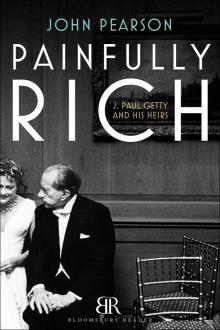- Home
- John Pearson
Notorious: The Immortal Legend of the Kray Twins Page 2
Notorious: The Immortal Legend of the Kray Twins Read online
Page 2
After which the old boy briskly thanked the jury and dismissed them. He commended the police and had a special word of praise for Detective Superintendent ‘Nipper’ Read who had ‘masterminded’ the investigation. And that was that. By the time the bulletproof police vans with their heavily armed escorts had rumbled off to the first of many prisons which would be the nearest thing to home the Twins would know until they died – Ron Kray to the so-called ‘mini-Alcatraz’, of the maximum security unit in Durham, his twin brother Reg to a similar setup in Parkhurst on the Isle of Wight – the little judge was in a taxi heading for the Garrick Club, where he was known as something of a wit and enjoyed lunching with a few old legal cronies at the long table under the portraits of those other actors, Olivier and Kean and the great Garrick himself in the role of Macbeth – who, come to think of it, was another famous murderer.
The judge was greeted warmly by his friends, and over the Garrick’s claret and kidney, steak and oyster pie they began to quiz him on the trial.
‘Well, Melford, you were pretty tough on them. Now it’s over, tell us what you really thought of them.’
‘What did I think? To be honest, I’ve never had such an unsavoury pair to deal with in my life. But, you know, they did say two things that were true.’
‘Like what?’
‘In the first place, one of them called our portly friend Kenneth Jones a fat slob.’
‘I’d not object to that. And what other nugget of truth did they offer?’
‘When one of them claimed that the judge was prejudiced against them, I fear he was.’
‘So you admit it, Melford. But would you really have been so happy to have topped them?’
Sir Melford nodded. ‘Certainly. They were the most suitable candidates for capital punishment I have ever encountered.’
‘Because they were unusually evil?’
‘All murderers are evil, but with the Kray Twins that was not the point. They were a profound danger to society, as I said. Society needs to see the back of Ronald and Reginald, and dead murderers can’t talk.’
‘Would it matter if they did? They had their chance to say anything they wished to at their trial. Why didn’t they?’
‘Because it didn’t suit them. But they could always change their minds, and if they ever do they could cause an awful lot of damage. Still, thirty years in maximum security should keep them quiet and help everybody to forget them. But with any luck I think you’ll find we’ve heard the last of Reginald and Ronald, and the rest of their unpleasant hangers-on.’
But Sir Melford Stevenson was wrong. Despite his verdict, prison life would not destroy them, and their extraordinary careers as criminal celebrities were far from over.
3
Birth: 1934
THE STORY OF the Twins began in February 1934 in the womb of Violet Kray, wife to a Hoxton rag-and-bone man called Charles Kray.
In spite of the rate of infant mortality in the old East End, buxom Violet had had no problem producing one good-looking healthy son already. He was born in 1931 and was christened Charles, in honour of his father – this despite the fact that there really wasn’t all that much to honour in the life of Charles Kray Sr. A lifelong boozer who, in the old phrase, ‘kept low company’, he would supplement his earnings by buying old gold brooches, wedding rings, and gold-mounted false teeth from needy widows he encountered on his buying expeditions through the south of England. In 1939 when war broke out and he was invited to defend his King and Country he would decline that honour too, instantly desert, and stay on the run for more than fifteen years. But Charlie was a wily bird, and thanks to the trade in second-hand false teeth and second-hand clothes he could always make a living and stay clear of the police, which was the most important thing a married man could do for his nearest and dearest in those hungry years.
Unfortunately for Violet, her parents were a pair of strong-willed Cockney puritans whose experience of the demon drink had made them lifelong teetotallers. So they had not been impressed by the prospect of Charles Kray Sr as a son-in-law. But Charles was obstinate: the marriage went ahead, and the young pair started married life in a two-roomed flat in Hoxton and had lived there ever since.
Then, two years later, when Violet discovered she was once more pregnant, she sensed that things were not the same as when she’d been carrying young Charlie. She did not know it then, but for reasons of its own the fertilised egg inside her had decided to divide and the two segments were producing two identical but separate human beings. A few weeks later, when she went along for her check-up at the Mare Street clinic, Violet was told that she was having twins.
This was the moment when the world of Violet Kray was changed for ever, as was that of her family, although at this stage none of them realised what they were in for. This included Charles Kray Sr who, when he heard the news, put aside some money which would normally have gone on booze and started saving for a double pram. His in-laws were so impressed by this that they felt the time had come to finally accept him as a member of the family. They began to make arrangements for Violet and family to move into an empty house two doors away from theirs in Vallance Road, Bethnal Green. Since her married sisters May and Rose were already living opposite, this meant that Violet would soon be back among her own, with everything more or less forgiven. So it was that before they were even born the Twins had made their presence felt and helped to bring the family together. And this was only the beginning.
For a married woman in the tough disease-prone world of the old East End, the birth of a pair of healthy twins was regarded as something of an achievement and Violet made the most of it. As she pushed that small impassive pair of agate-eyed monsters out in Charlie’s brand new pram, she knew that she was special too. To make the most of this, she did everything she could to show the world that they were twins and to emphasise the difference between them and all the other kids in Bethnal Green. She dressed them identically in smart blue coats and white angora berets, ‘so that they looked just like two little bunny rabbits in their pram’. She chose the names Reginald and Ronald for them, ‘because the two names went so well together’. And when she wanted them to come to her, she always called out ‘Twins’, rather than ‘Reggie and Ronnie,’ as if they were one person with a single name. This was how the Twins grew up, in their private little world at the centre of the village-like community of Bethnal Green, where everyone knew everyone else and all the other children knew that Violet’s twins were special. Even brother Charlie knew it and reluctantly accepted it, which was tough on Charlie, and he never quite got over it. But now that the Twins had started life as miniature celebrities they would go on being special when they were miniature no longer.
There was more to it than that. If the Twins were special, so was Violet, which meant that, like it or not, all three of them were joined in a more or less unconscious conspiracy, and as the years went by Violet was going to depend upon the twins for any self-esteem she had. Without them, she would have been Mrs Nobody, like May and Rose or any mother from Bethnal Green with a humdrum life and a wayward husband. Similarly, without Violet’s devotion, in the rough, tough world of the old East End the Twins would have been two weird and isolated small boys, with no one to rely on or support them. But as long as the bond between the three of them endured, so would the special status that underpinned the trio’s mutual self-respect.
This had its drawbacks. Being special meant being different, and there always would be something strange about the Twins. ‘It’s hard to say exactly what it was, but they weren’t like other children,’ said their cousin Billy Wilshire, and people who knew them still remember how self-contained they seemed to be within the little world that they inhabited. As Ron himself put it when he talked to me about this many years later: ‘We had our mother, and we had each other, so we never needed no one else.’
4
Twins: 1937
IT DIDN’T TAKE the doctors long to discover that the Twins were even more remarkable tha
n their mother thought they were. The most common sort of twins are so-called binovular twins, which occur when two eggs become fertilised within the womb. For all intents and purposes such twins usually turn out like ordinary siblings, each with a separate genetic make-up, physique and personality. Identical twins are different. In their case, when the single fertilised egg divides within the womb it produces twins who are literally identical, with the same genetic make-up, the same psychology and physique, and – as with Ron and Reg until they were well into their early twenties – they can be facially indistinguishable. Such twins are, in fact, one of the stranger quirks of human physiology.
Until you get accustomed to identical twins it can be disconcerting to be faced with what appears to be a human being in duplicate, often showing the same mannerisms, the same gestures, and with each twin’s face an exact image of the other’s. One theory has it that because we’re not accustomed to seeing double versions of the same person, our first reaction is to feel baffled and uneasy in their presence. In the past this often caused identical twins to be treated with both fear and fascination. In some primitive societies they were regarded as ill-omened, and were sometimes even put to death at birth to avert divine displeasure, while others found something supernatural in their make-up. The ancient Greeks, who detected gods or demigods in almost everything, gave identical twins a special place in their mythology. Thus, when Zeus – who as father of the gods should have known better – tricked Queen Leda into having sex with him by disguising himself as a swan, the sacred nature of the copulation resulted in the birth of the heavenly twins, Castor and Pollux, whose immortality lives on in the twin stars still named after them.
In medieval England twins were sometimes found in freak shows and were shown at circuses. But in modern times scientists have started to take identical twins more seriously and, realising the importance of having two individuals with an identical genetic make-up, have begun studying their behaviour in depth.
In the 1930s one such scientist, the Austrian criminologist Lange, made a fascinating study of identical-twin criminals who had become separated at birth. Lange ended up convinced of the crucial role of heredity in criminal personality. If he was right, since Ron and Reg shared an identical set of genes, then if one twin showed a tendency to crime the other would be inclined to follow.
Normally, inherited similarities between identical twins tend to taper off with adolescence and can vanish completely with the advent of maturity as genetic similarities get overshadowed by environmental differences. But here again, the Kray Twins would be different and this disengaging process would not occur, thanks to another untoward event which was going to affect them both profoundly. At the age of three the bonds of twinship tightened so dramatically that the Twins would effectively stay locked together for the rest of their lives.
Until now the two boys had been extremely healthy and only Violet could tell the two of them apart. When Reggie was taken ill and the doctor diagnosed diphtheria, their mother knew that Ronnie would almost certainly succumb as well. He did so three days later.
This was serious. Diphtheria is an acute infectious disease in which a membrane sometimes forms within the throat, which can cause death by suffocation. The disease can also produce dangerous neurotoxins that damage the central nervous system. Today diphtheria is virtually a disease of the past, almost totally eradicated by immunisation; but in those days it was highly contagious and potentially deadly, particularly in the deprived conditions of pre-war Bethnal Green. So for the first time in their lives the Twins were separated and sent to different isolation hospitals, Ron to the Homerton Fever Hospital and Reg to one in Hackney. Both of them were seriously ill but within a few weeks Reg had started to recover and was soon sent home. Ron, though, showed no improvement. He remained painfully weak and seemed to lack the will to live. By now all hope for him was fading fast.
I remember the pride with which Violet described every detail of her starring role in the crisis that ensued. This was obviously one of the great moments of her life and it provides a key to her future relationship with the Twins. She described how she realised at once that the doctors had given up on Ronnie, and she knew the time had come to assert herself if her precious child was going to survive. So she refused to listen to the doctors and against their advice insisted on bringing Ronnie home to Vallance Road. ‘The doctors didn’t understand him but I did. It stands to reason. As his mother, I knew exactly what was wrong with him. He was simply pining for me and for little Reggie, and once he was back with us he started to recover. But he seemed so precious to me now that I couldn’t bear to let him out of my sight, and I had him sleeping with me in my bed for the next six months or so.’
Violet was never going to forget how she had saved Ronnie’s life. But this period of the little boy’s convalescence would also have a most profound effect upon the natural balance previously maintained between the Twins. Until then, as the first-born twin Reg had been the dominant one and during the months following their return from hospital it seemed as if this was going to continue, for Ron was slower now and seemed less energetic than his brother. But gradually Ron discovered how to compensate for this through bouts of bad behaviour, and by involving Reg in any devilment going. Sudden tiffs and outbursts of temper are common between identical twins and are usually followed by sunny periods as the balance between them is restored. With the Kray twins, this balance seemed to have become fatally upset after Ronnie’s illness.
The twin relationship had become what is technically known as ‘discordant’, which can happen when one member of a pair of twins has been damaged or impaired. When this happens and the balance between them is destroyed their whole relationship can be at risk. This can become serious. Sometimes one of the twins can fail to survive, or both of them can end their lives in institutions for the emotionally retarded. But with Ron and Reg the outcome was different. Although it seemed that Ron’s nervous system had definitely been damaged by his illness he fought against the situation, gaining strength from Violet who was always there to love him and to back him up against his brighter, quicker brother.
Throughout the Twins’ childhood it would often be a no-holds-barred situation as backward Ron discovered different ways to assert himself and hold on tight to Reg. After involving him in some wickedness or other he would end by staging an emotional appeal. At other times the Twins would fight each other furiously. They were becoming more violent with every year that passed and sometimes seemed to fight each other almost to the death.
By now, violence seemed to play a crucial role in their relationship as twins, with Ron always goading Reg until he lost his temper, and the fighting would go on until they seemed united in their rage against each other. At this point the fight would stop as quickly as it had started, and somehow Violet always forgave them because she loved them – especially Ronnie, who needed her affection so much more than Reggie.
At times Reg made determined efforts of his own to escape from the situation. But Ron was always there, and just when Reg seemed on the point of asserting his independence a sense of pity or responsibility for the dependent twin he was abandoning would bring him back. Thus Ron, although originally the weaker and younger of the two, discovered ways to use his weakness to arouse his mother’s love and make Reg do his bidding. This suited Ron, of course, but for Reg this situation came to dominate their adolescence, especially as Ron’s strength steadily increased. Thus Ron’s childhood diphtheria ended up by robbing both the Twins of any chance of living separate lives. And slowly, inexorably, this closeness came to rule their whole existence.
5
East End
ONCE THEY WERE over their diphtheria it was time for an altogether different influence to home in upon this locked-together pair of twins. In pre-war Bethnal Green they were growing up within a world unlike any other.
Somewhere in the distant past, when Bethnal Green still had its village green and there was a white chapel in Whitechapel, the country
bordering the Thames to the east of London was not unlike the country to the west, with the same green fields and farms and riverside villages. But as London expanded and the City and the country to the west grew in prosperity, the east was left to fester on its own, becoming in the process the dumping ground for everything that the wealthiest city in the world wanted to ignore. What better spot to place London’s antisocial industries, not to mention its surplus human beings, with its acres of cheap slum dwellings being thrown up to house the casual labour needed in the sweatshops and the foundries and the miles of dockland bordering the river.
The East End’s first immigrants were French Huguenot Protestants who arrived at the end of the seventeenth century, fleeing Catholic persecution in their native land. They prospered, creating a flourishing silk industry in Spitalfields and building fine houses, some of which survive in Fournier Street off Brick Lane. They even built a chapel of their own, which later became a synagogue and today is a temple for the local Bengali community. For the Huguenots were followed by waves of poorer immigrants: Jews from the pogroms of Eastern Europe, Irish escaping from the potato famine who couldn’t make it to America, gypsies who settled among them to look after the horses, all of them crammed together in what rapidly became some of the worst slums in Europe and struggling to exist upon what little was on offer.
This meant that London had become a divided city, with all the power and wealth and splendour on one side and just down the road beyond Bishopsgate the start of grinding poverty and human degradation. The East End criminologist Dick Hobbs called it ‘a forgotten country, the land of the living dead.’

 The Bellamy Saga
The Bellamy Saga Notorious: The Immortal Legend of the Kray Twins
Notorious: The Immortal Legend of the Kray Twins Learn Me Good
Learn Me Good James Bond: The Authorised Biography
James Bond: The Authorised Biography Painfully Rich
Painfully Rich The Profession of Violence
The Profession of Violence Biggles
Biggles Blood Royal: The Story of the Spencers and the Royals
Blood Royal: The Story of the Spencers and the Royals